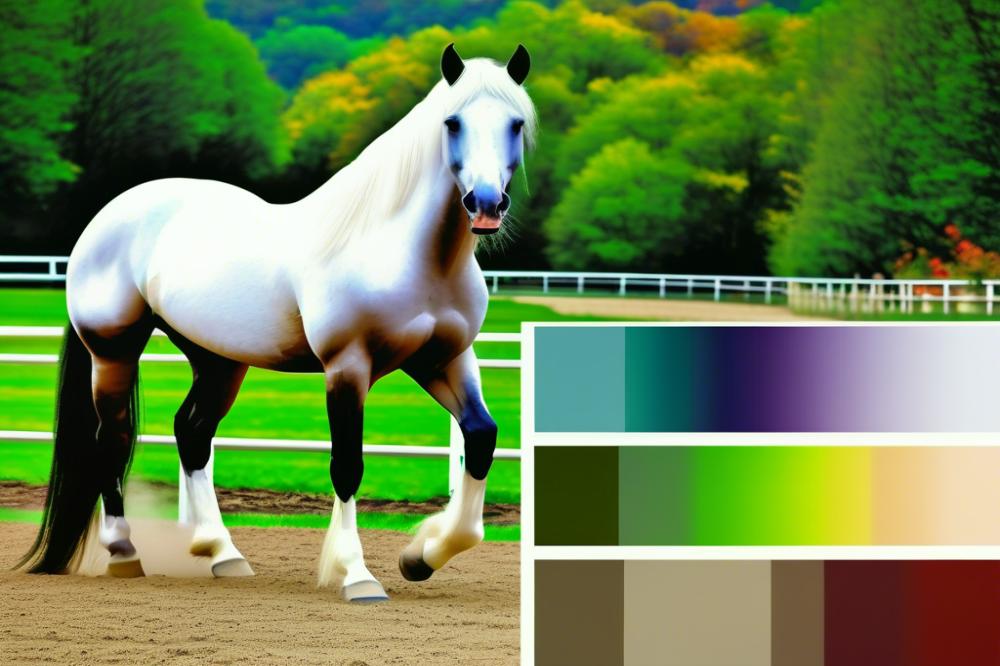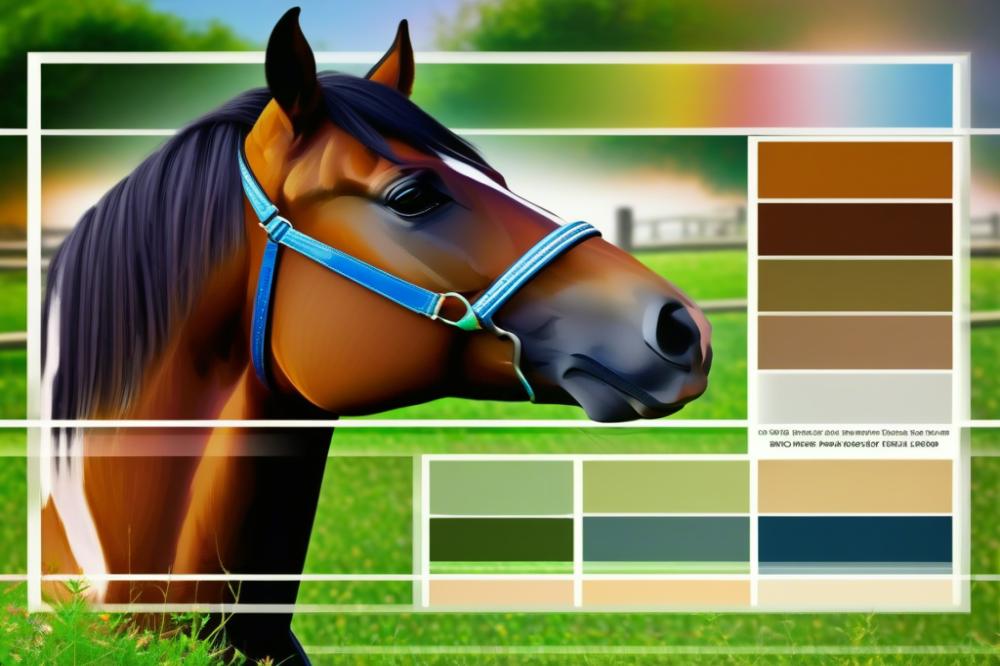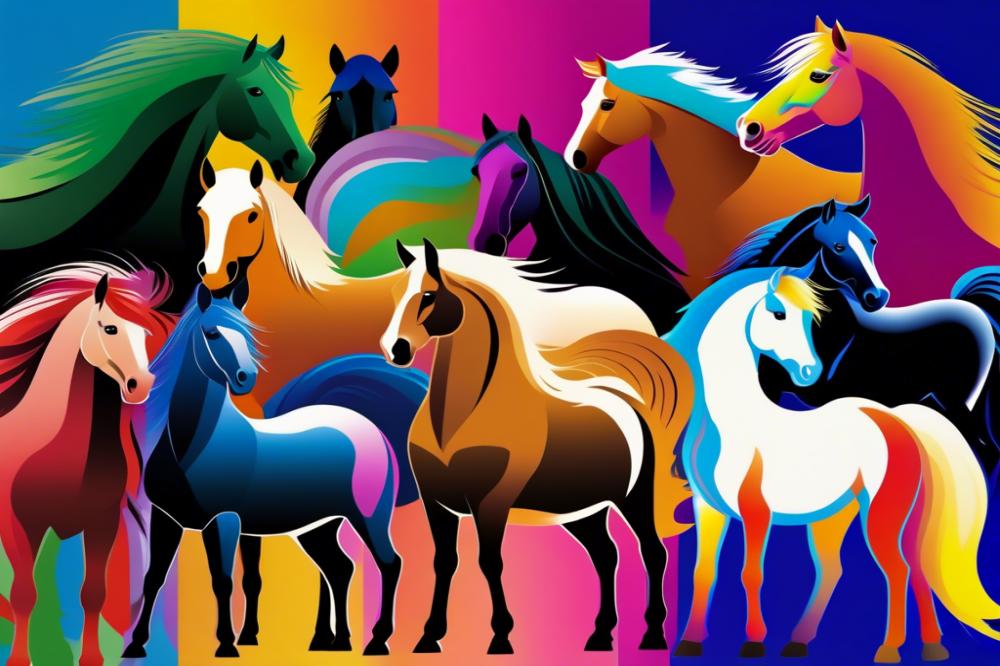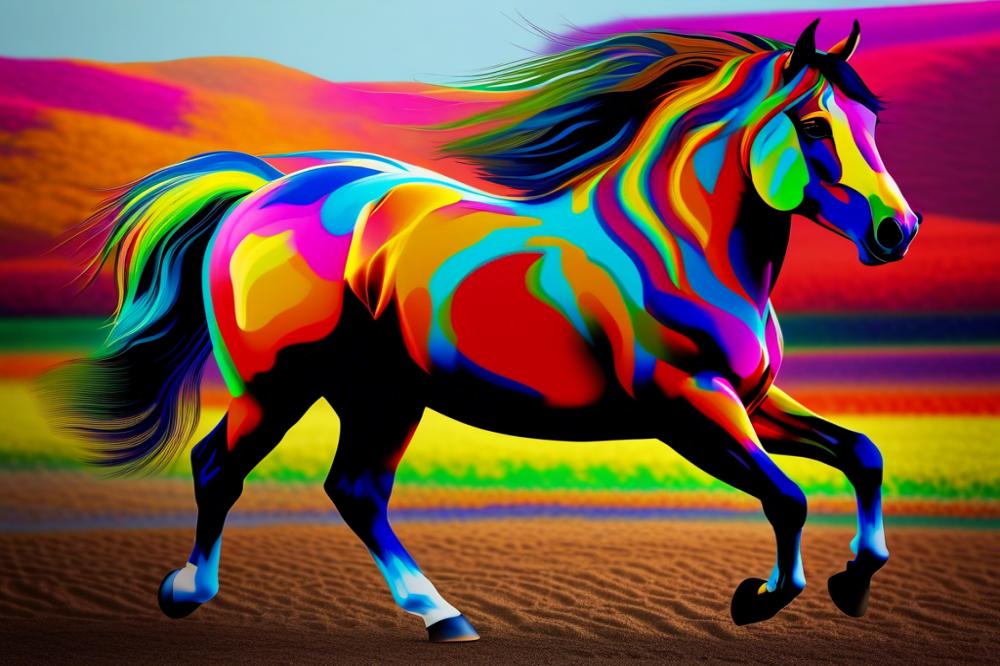Exploring the Colors of Horses
When it comes to horses, color is more than just a pretty coat; it’s an essential part of what makes each breed special. For horse lovers and breeders alike, the variety of horse coat colors adds an extra dimension of interest to these magnificent animals. Just think about it: with so many shades and patterns, every horse can tell its own story right through its appearance. Color can represent a horse’s lineage, personality, and even its role on the farm. So the significance of color in horse breeds is not simply about aesthetics; it can reveal a lot about equine characteristics, history, and culture.
What makes a horse breed colorful? It’s not just the basic colors we often think of like black and white. Single-colored coats might be nice, but in the horse world, the fun really begins with unique patterns and mixes. From dapple gray to piebald and everything in between, every stunning hue showcases the horse’s own story. Many horse breed information resources highlight these variations, showing that a colorful horse’s coat can change with the seasons or even as it matures. In fact, some breeds are known for specific colors because of their genetics. Talk about nature’s artistry!
This article seeks to dive deeper into the world of colorful horses. We will explore different breeds known for their vibrant coats, while also touching upon tips for horse care relevant to these stunning animals. If you’ve ever wondered, “Can a horse eat chocolate?” or had questions about the needs of colorful horses, you’ve come to the right place. Get ready to learn and appreciate the paintbrush of nature’s palette as we explore all breeds of horses with that dazzling flair. Let’s saddle up and ride into the colorful world of horse breeds!
Understanding Horse Coat Colors

Horse coat colors spark interest for many folks. Genetics plays a big role in how these colors appear. Each horse inherits its colors from parents. It’s like a lottery, where some genes win and others don’t. At first glance, a horse’s coat might seem simple. Yet, under the surface, there’s a tangled web of traits waiting to be unraveled.
Explanation of Equine Coat Color Genetics
Let’s dive into equine characteristics for a moment. DNA determines traits like coat color, and it’s a bit like a recipe card. If you mix different ingredients, you get unexpected results. For instance, a chestnut horse can have foals that are bay or gray. Specific genes control these colors, with dominant traits showing up more often. It’s fascinating how some colors stick in a family while others skip a generation.
Common Color Patterns and Terms
When it comes to horse coat colors, there’s a whole array of terms to know. The classic colors like black, brown, and white are just the tip of the iceberg. Each shade adds personality to the horse. Some common patterns include spots, stripes, and patches. Appaloosas have distinct spots, while pintos mix large swathes of color with white. Calling a horse “roan” means it has a mixture of colored and white hairs, making it look special in any crowd!
Influence of Breed on Color Variations
There’s no denying that horse breeds matter when discussing color variations. Various breeds are known for particular shades. For instance, Arabians tend to be gray or bay, adding elegance to their speed. Paint horses are famous for their unique mix of white with darker shades. Even within breeds, individual horses can display a wide range of colors. Each breed carries its own special traits, influencing how colors show up. So, when you’re gathering horse breed information, keep an eye out for what colors are typical for each type.
Colorful horses capture our hearts and imaginations. Some might compare them to a box of crayons, each one unique and eye-catching. Knowing more about these genetic traits can make horse care even more interesting. The beauty of colors can deepen our appreciation for these magnificent animals.
Top Colorful Horse Breeds

Appaloosa
Appaloosas are fascinating horses, known for their distinctive coat patterns. These colorful horses can have spots and splotches of color, making each one a work of art. Their coats come in various shades, including bay, black, and chestnut. Along with their stunning appearance, Appaloosas are admired for their endurance and gentle temperaments. Owners cherish their unique equine characteristics, as they can be friendly and loyal companions.
Paint Horse
Next up is the Paint Horse, which boasts a striking coat that combines white with other colors. Imagine a horse that looks like a brushstroke masterpiece! Their patterns can range from large patches to smaller spots. This breed is known for its versatility in various disciplines. Whether competing in rodeos or enjoying leisurely rides, Paint Horses stand out beautifully in any setting. Horse care for this breed requires attention to their colorful coat colors, but their vibrant personalities make it all worthwhile.
Quarter Horse
Did you know that Quarter Horses come in all sorts of coat colors, including palomino? This breed is famous for its strength and agility, often excelling in ranch work and rodeos. Many people love the Quarter Horse for its friendly nature and calm demeanor. A well-cared-for horse can be a fabulous partner for beginners and experts alike. Plus, the variations in color add an extra flair to their already impressive presence.
Pinto
Pintos are recognized by their bold color patterns that sport large patches of white mixed with another color. Some might say they look like they came straight out of a painter’s canvas! These horses can be found in various breeds, making them quite versatile. Owners of Pintos enjoy the vibrant appeal they bring, adding excitement to every riding experience. They often have fun personalities, too, which makes horse care enjoyable. Every Pinto horse can be an adventure waiting to happen.
Palomino
Palominos shine bright with their golden-yellow coats that resemble freshly baked cookies! Their striking appearance often turns heads wherever they go. This breed can vary in shade from light cream to deep gold. Because of their beauty, they hold a special place in the hearts of many horse lovers. Palominos are usually friendly and eager to please, which makes them great for riders of all experience levels. Horse breed information on Palominos reveals that these colorful horses often know how to steal the spotlight.
Unique Characteristics of Each Breed

When exploring horse breeds, color plays a big part in attracting our attention. Colorful horses, like the Appaloosa, have distinct coat patterns and spots. Imagine a horse with a coat as polka-dotted as a child’s favorite shirt! These striking traits are just one of the many equine characteristics that make them special.
Some breeds, such as the Paint Horse, are famous for their large patches of white mixed with other colors. Each horse looks like a walking work of art. Just like how every artist has a unique style, no two Paint Horses are alike. Then there are the Palominos, who flaunt a shiny golden coat that can make anyone think of treasure. The dazzling hue captures sunlight beautifully!
Physical and Behavioral Traits
Colorful breeds don’t just shine in appearance; they bring personality to the table, too. The Arabian horse is not only known for its beauty but also for its spirited nature. These horses are often affectionate and love to cuddle. In contrast, the Fjord horse has a calm demeanor and a distinctive two-tone mane. Anyone who has met a Fjord can tell you how friendly they are.
Some breeds have particular physical traits that stand out aside from their colors. The Appaloosa possesses unique striped hooves, which can be a surprising feature! Meanwhile, the Clydesdale, known for its large stature, displays powerful muscles covered in a beautiful coat, often with white markings. They all have something that sets them apart.
Diversity in Temperament and Use
Each breed also serves different purposes. Some horses, like Thoroughbreds, excel in speed and racing. Others, such as Quarter Horses, are champions in ranch work. It’s fascinating to see how a breed’s coat colors can coincide with its history. Many colorful horses are true all-rounders. They can excel in various disciplines, from jumping to dressage, merely proving that color can coincide with capability.
Temperament varies widely across horse breeds too. Some horses are playful clowns, whereas others prefer a more serious approach. The versatile Morgan horse is known for its enthusiasm and willingness to try new things, making them a favorite among riders. Each horse in the pasture has its own personality, just like people.
The Role of Color in Breed Registries
Breed registries take color seriously. Certain horse coat colors are key factors when it comes to registering for some breeds. For instance, only horses with a specific color pattern can qualify as a true Appaloosa. This is where it gets interesting! Owners spend time researching horse breed information to understand how color impacts value and classification.
Interestingly, some breeds even celebrate unusual colors that might not fit the traditional mold. Registries aim to preserve these unique traits, which could otherwise fade away over time. A wild, unexpected shade can turn heads, and those colorful horses often attract a lot of attention. Who doesn’t love a horse that stands out in a crowd?
In the end, learning about these horse breeds offers more than just a rainbow of colors. It’s an insight into their diverse traits, personalities, and roles within our lives and society.
Cultural Significance of Colorful Horses
Historical Associations with Color
Many cultures throughout history have attached meanings to different horse coat colors. For example, a chestnut horse might signify vitality, while a white horse has often been linked to purity or nobility. Ancient civilizations even believed that certain colors brought good luck or warned of impending danger. These historical ties reflect how our ancestors viewed these majestic animals. Different horse breeds showcase a variety of colors, influencing their significance across the ages.
Colorful Horses in Art and Folklore
Art has long celebrated the beauty of horses in vibrant hues. Painters like Leonardo da Vinci and Albert Bierstadt captured these animals in stunning detail. Folk tales often include magical steeds with unusual coat colors. Legends tell of horses that can fly or take on human forms. These stories highlight how colorful horses capture our imagination. Artists and storytellers have spread the allure of these equines through generations.
The Impact of Color on Equestrian Sports
In the world of equestrian sports, color can play a surprising role. Horse coat colors may affect a competitor’s choices in disciplines like dressage or show jumping. Sometimes, riders pick a horse based on its eye-catching shade, aiming to stand out. Brightly colored horses often grab attention during events. This visual appeal can create a buzz around them, leading to cheers from the crowd. Learning about horse breed information helps owners care for their vibrant companions.
Not all riders may consider their horse’s color as important, but it can make a difference. Colors can influence how spectators perceive performance. A well-groomed horse with a striking coat may earn extra admiration. Some believe that colorful horses can even inspire their riders to perform better. Equestrians who have a colorful companion often develop a strong bond, making their story even more special.
Care and Maintenance of Colorful Horses
Considerations for Grooming and Coat Care
Grooming colorful horses is more than just making them look pretty. Regular brushing helps remove dirt and loose hair. Different horse breeds may require various grooming tools. Brushes with softer bristles work well for sensitive skin, while firmer brushes tackle tougher coats.
Coat care can also involve a good wash now and then. A gentle shampoo will keep their colors vibrant. Those striking horse coat colors may fade if not cared for properly. Always rinse out shampoo completely to avoid skin irritations.
Bath-time can be a fun experience for both you and your horse. Some horses enjoy the splash of water, while others may just want to roll in the mud afterward! Sharing this time can build a deeper bond.
Common Health Issues Related to Coat Color
Interestingly, certain horse breeds with specific coat colors can face unique health challenges. For instance, light-colored horses often have more sensitive skin. Sunburn can become a problem for those with paler coats. It’s always wise to provide shade and use sunscreen made for horses if possible.
Also, some horses may be prone to genetic conditions linked to their colors. For example, foals with overo coloring can suffer from certain health issues. Paying attention to their breed information helps owners understand these potential risks.
Keep an eye out for skin conditions, too. Colorful horses can get infections just like any other horse. If you notice any unusual spots or irritations on their skin, consult a veterinarian for advice.
Importance of Proper Nutrition for Coat Health
Nutrition plays a key role in maintaining a beautiful and healthy coat. Horses need a well-balanced diet filled with vitamins and minerals. Those requirements vary by breed, so it’s essential to tailor their feed accordingly.
Omega fatty acids work wonders for coat shine. Supplements designed for skin and coat can be beneficial as well. Strong equine characteristics often come from proper feeding. Healthy horses not only look vibrant but also feel good.
Always remember to provide fresh water alongside their meals. Dehydration can lead to dull fur, and nobody wants that! Regular check-ups with a vet will help you learn more about your horse’s specific dietary needs.
Treat your colorful companions right, and they’ll reward you with their stunning beauty!
The Future of Colorful Horse Breeds
Trends in Breeding for Color
Breeding for color in horses is becoming more popular. Enthusiasts often seek out specific horse coat colors that catch their eye. Many breeders are now focusing on colorful horses, making them appealing to buyers. Gaited breeds and draft horses have joined the trend. Breeders recognize that color can help sell a horse faster. It’s not just about athletic ability anymore; it’s also about looking good! Some breeds, like the Appaloosa, always attract attention due to their beautiful spots. The twist is that genetics play a big part too. Genetic testing can reveal hidden coat colors, which sometimes surprises even experienced breeders.
Conservation of Traditional Colorful Breeds
Protecting traditional breeds is just as crucial as breeding for new colors. Some colorful horse breeds have a long history and unique equine characteristics. People are starting to realize that these horses need support. Organizations and dedicated individuals work tirelessly to preserve these horse breeds. With efforts in conservation, we can enjoy their vibrant coats for generations to come. Horse lovers often participate in community events to raise awareness. Learning about breed history can also spark interest in their care. It’s a win-win for everyone involved! Plus, who wouldn’t want to see a stunning, color-patterned horse galloping through a field?
Forecasting the Popularity of Horse Colors in the Future
Predictions about horse coat colors show some exciting possibilities! As more riders and owners become aware of the diverse options, colorful horses are likely to gain popularity. Younger generations love Instagram and TikTok, which showcase these eye-catching animals. A flashy coat can quickly make a horse a star on social media. With that fame comes greater interest in unique breeds, especially those with unusual patterns. Also, as people learn more about horse breed information, they may lean towards more distinctive traits. Colorful horse breeds may even inspire trends in horse gear and accessories. Enthusiasts may see a future where owning a colorful horse is a badge of honor.
Final Thoughts on Color in the Equine World
As we wrap up this colorful journey, it’s easy to see why so many people are captivated by the vibrant beauty of certain horse breeds. Their stunning coats and striking appearances grab our attention and spark joy. Who doesn’t like a splash of color? Imagine watching a horse gallop under a sunny sky, its coat shimmering in the light. It’s simply breathtaking!
Next time you catch a glimpse of a beautifully painted horse, take a moment to appreciate the artistry of nature. After all, these creatures possess more than just charm; they have stories, personalities, and dreams of their own. Whether it’s an exciting tale of adventure seen in a horse movie for kids, or the unique bond forged in the riding arena, the magic of horses goes beyond their colors. Each shade tells a story, each pattern a history.
Talking about riding styles, every horse has a role—some shine in english vs western riding, taking on varied challenges and showing off their flair. It’s the uniqueness of their coats that can enhance our experience, making every moment spent with them more memorable. So, if you ever thought about adopting or supporting a colorful breed, go for it! It’s like finding that perfect piece of art that just speaks to your soul.
In closing, remember that color can create a powerful impact in the equine world. It’s not just about pretty shades; it’s about the connections we build with these remarkable animals. Keep your heart open to the world of horses, and who knows what delightful surprises await you? Embrace the colors and relish the stories that each horse brings into our lives.



